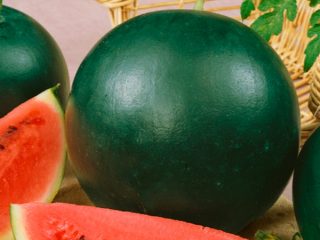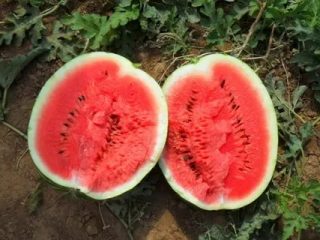Content
Due to its sugar content and high content of nutrients, watermelon is considered one of the most delicious treats for both children and adults. In the old days, growing watermelons was the exclusive prerogative of residents of the southern regions of Russia, since this berry is very picky about the amount of heat and sunlight. But not everyone likes to feast only on imported watermelons, since there is no way to control what was put into them during cultivation.
Therefore, many summer residents and gardeners in central Russia tried to experiment with growing watermelons in their garden plots. In recent years, this task has been simplified with the emergence of many varieties and hybrids, which, having the shortest ripening time, also have a real watermelon taste and decent fruit size. Holland has always been one of the main suppliers of seeds of various kinds of interesting plants to the Russian market. Therefore, it is not surprising that the Bonta watermelon, whose cultivation in the middle zone has positive reviews, was produced by breeders from the Netherlands.
Description of the variety
Watermelon Bonta f1 is a hybrid obtained at the beginning of the 21st century with the help of specialist breeders from the Dutch company Seminis, which at that time had already been absorbed by the Monsanto Holland B.V. corporation. Therefore, the originator of this hybrid variety was Monsanto.
In 2010, this hybrid was officially included in the State Register of Breeding Achievements of Russia with recommendations for cultivation in the North Caucasus and Lower Volga regions. But many summer residents and gardeners have adapted to using film tunnels and non-woven materials when growing watermelons. Thanks to these auxiliary shelters, the geography of growing watermelons in general, and this hybrid in particular, has greatly expanded. This hybrid variety can be found not only in the Central Black Earth region, but also in the Moscow region and the Volga region. Bonta watermelon is also grown in greenhouses and produces quite decent fruits with good taste characteristics.
In Russia, the seeds of this hybrid can be purchased either in branded farm packages from the Simenis company or in packaging from the seed companies Gardens of Russia and Rostok.
Bonta watermelon is an early-ripening hybrid in terms of ripening time. For watermelons, this means that the period from full germination to the ripening of the first fruit is from 62 to 80 days. In this case, the ripening of fruits occurs quite smoothly. The plants themselves look relatively compact, although they are distinguished by great growth vigor. The main lash is medium in size - does not exceed 1.5-1.8 meters in length. The leaves are medium sized, green, well dissected. A feature of ripening is that the second and subsequent fruits on the vines do not become smaller in size.
Moreover, the distinctive ability of this hybrid is the ability to obtain a harvest even in weather conditions that are not the most favorable for watermelons. In particular, the Bonta hybrid is characterized by high drought resistance.
The productivity of this watermelon hybrid is at a fairly high level. In fields without irrigation (rainfed fields) it can range from 190 to 442 c/ha, and in the first two harvests alone you can collect 303 c/ha. And when using drip irrigation, productivity can double or even triple.
Bonta watermelon demonstrates high resistance to many fungal diseases, primarily to anthracnose and fusarium.
Fruit characteristics
The fruits of this hybrid are closest to the type of watermelons of the Crimson Sweet variety. Thanks to its outstanding taste and external qualities, the Crimson Sweet variety has become a kind of standard for most watermelon varieties and hybrids.
- The bark of Bonta watermelons is very dense, so it is well adapted to protect the fruit from sunburn.
- The shape is correct, closer to spherical.
- Watermelons can grow to significant sizes. The average weight of one fruit can vary from 7 to 10 kg. The diameter can reach 25-30 cm.
- The fruits are light green in color with dark green stripes of medium width.
- The pulp is dense, very juicy and crispy.
- The color of the pulp is rich red, it tastes very sweet, almost honey. The fruits also have a very attractive aroma.
- Watermelons are uniform in size and shape and have a good presentation.
- The seeds are medium sized, brown in color with a spotted pattern.
- Due to the dense peel, the fruits can be stored for a long time and can withstand almost any transportation.
Features of cultivation
Bonte watermelon can be grown in two ways: by sowing seeds directly into the ground or by seedlings.
Sowing seeds in the ground
This method can only be used by residents of the southern regions. Watermelon Bonte is very light- and heat-loving and does not tolerate even the slightest frost. The soil temperature for sowing should be on average +12°+16°C. About a day before sowing, the seeds are kept in water at a temperature of about +50°C. It is best to do this in a thermos. After the seeds begin to hatch, they are planted in holes to a depth of 6-8 cm with an interval of about one meter between them. To speed up the growth and development of plants, seedlings can be covered with non-woven material or inverted plastic bottles with the neck cut off.
Seedling method
For most residents of Russia, it makes sense to use seedlings to grow watermelons. This will provide a guaranteed opportunity to obtain a harvest in conditions of too short a summer. It makes sense to grow seedlings from the end of April - beginning of May, so that 30-day-old plants can be planted in the ground. First, the seeds are heated in warm water at a temperature of +50°-+55°C. They can then be germinated in warm sand or damp cloth. When small seedlings appear, the seeds are placed in separate pots, 1-2 seeds per container. The pots are pre-filled with a light mixture of sand, peat and turf soil. Containers with sown seeds are covered with transparent polyethylene and placed in a place with a temperature of about +30°C.
After germination, the polyethylene is removed and the pots are placed in a bright place.As watermelon seedlings grow, the temperature gradually decreases until it reaches +16°+18°C.
After a month, Bonta watermelon seedlings will form 5-6 true leaves and can be transplanted into open ground to a permanent location.
Bonta watermelon will perform best when grown in unshaded, sunny areas with light sandy soils. If the soil on the site is heavy, then in the area where watermelons grow, you need to add at least a bucket of sand for each square meter.
Nitrogen fertilizers should be applied only when planting watermelons. In the future, it is advisable to use mainly phosphorus-potassium fertilizers. During the entire growth period, watering can be done about 3-4 times. During the period when the fruits begin to ripen, watering is completely stopped.
Reviews from gardeners
Bonta watermelon has received mostly positive reviews; many people like it for its early ripening, excellent taste and ease of cultivation.
Conclusion
Bonta watermelon has all the necessary characteristics for growing it in many regions of Russia, and not just in the southern regions. Therefore, beginners in gardening can safely recommend this hybrid for their first experiments with watermelons.















